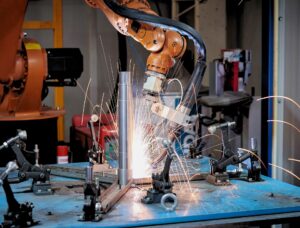Weld porosity is one of the most common and frustrating weld defects. These tiny gas pockets or voids trapped in the weld metal compromise welding quality, leading to weak joints, contamination, and even structural failure. Porosity can occur in all types of welding—from TIG welding and MIG welding to metal arc welding and plasma arc welding. To ensure solid welds, it’s essential to know how to identify and fix welding porosity using modern weld monitoring systems, and effective ways to prevent and correct it. Whether you’re using a welding camera manufacturer’s system or relying on traditional welding inspection techniques, catching porosity early makes a big difference in the final result.
What Causes Welding Porosity?
Porosity usually forms when gas becomes trapped in the weld pool and doesn’t escape before solidification. Common causes include:
- Contaminated Base or Filler Metal – Oil, rust, or paint can produce gas when heated.
- Improper Shielding Gas Coverage – Wind, wrong flow rates, or faulty equipment can let air into the weld.
- Moisture – Water in the base metal or electrode coating turns into steam, forming gas pockets.
- Wrong Welding Technique – Incorrect angle, travel speed, or arc length can disturb gas shielding.
- High Welding Current – Excessive heat can trap gas inside the weld.
A weld monitoring camera can help identify porosity in real time by providing clear arc welding images, making it easier to detect gas entrapment during welding.
How to Identify Welding Porosity
- Visual Weld Inspection
Look for small holes, bubbles, or craters on the surface. While not all porosity is visible, many signs can be spotted with welding visual inspection tools. - X-ray or Ultrasonic Testing
For critical welds, non-destructive testing can reveal internal porosity. This is common in laser welding, robotic welding, and high-spec applications. - Use a Weld Monitoring System
Modern weld monitoring systems equipped with high-resolution welding cameras capture live footage of the weld pool. These tools help identify inconsistencies and ensure a clean, gas-free weld.
How to Prevent and Fix Welding Porosity
1. Clean the Workpiece Thoroughly
Remove all rust, oil, moisture, and paint before welding. Use a wire brush, grinder, or degreaser to prep the surface.
2. Use the Correct Shielding Gas
Ensure consistent coverage. For example:
- TIG welding (Tungsten Inert Gas) – Use 100% argon or a mix depending on the material.
- MIG welding / MIG and MAG welding process – Check for proper flow rates and hose integrity.
Use a camera for welding to monitor gas coverage visually and adjust in real time.
3. Dry Electrodes and Filler Rods
Store consumables in a dry place. Preheat if needed, especially in metal arc welding where flux-coated rods can absorb moisture.
4. Adjust Welding Parameters
Too much heat or incorrect arc length can introduce porosity. Fine-tune your welding equipment settings—amperage, voltage, and travel speed—to create a stable arc and proper gas coverage.
A weld monitoring system can help you optimize your welding technique by showing the arc behavior clearly through real-time arc welding images.
5. Practice Good Welding Technique
- Maintain a short and consistent arc length.
- Avoid excessive weaving.
- Don’t weld over slag or previously contaminated areas.
Following the proper welding technique reduces the risk of both porosity and slag inclusion.
6. Use Backing Gas or Purging (For TIG and Pipe Welding)
When welding stainless steel or pipe, using a backing gas like argon on the root side can prevent oxidation and gas entrapment.
How Weld Monitoring Technology Helps Reduce Porosity
Weld monitoring cameras and inspection systems offer a proactive way to manage porosity:
- Real-time Feedback – Spot porosity formation as it happens and take corrective action.
- Process Optimization – Analyze welding parameters and correct bad habits.
- Welding Inspection – Confirm weld soundness without waiting for final testing.
- Documentation – Store welding data and images for quality assurance and traceability.
Using a high-performance camera for welding from a trusted welding camera manufacturer helps welders and engineers reduce porosity and other weld defects across a variety of applications.
Conclusion: Master Porosity for Stronger Welds
Porosity may be small, but its impact on welding quality is massive. From MIG welding to TIG and laser welding, using clean materials, proper shielding, and advanced welding inspection tools helps prevent porosity before it starts.
Pair your skills with modern technology like weld monitoring cameras and improve both the precision and reliability of your welding.
Mecaweld offers cutting-edge weld monitoring systems, welding cameras, and inspection tools designed to detect and eliminate porosity and other weld problems. Contact us today to explore how our solutions can help you achieve flawless, defect-free welds.



